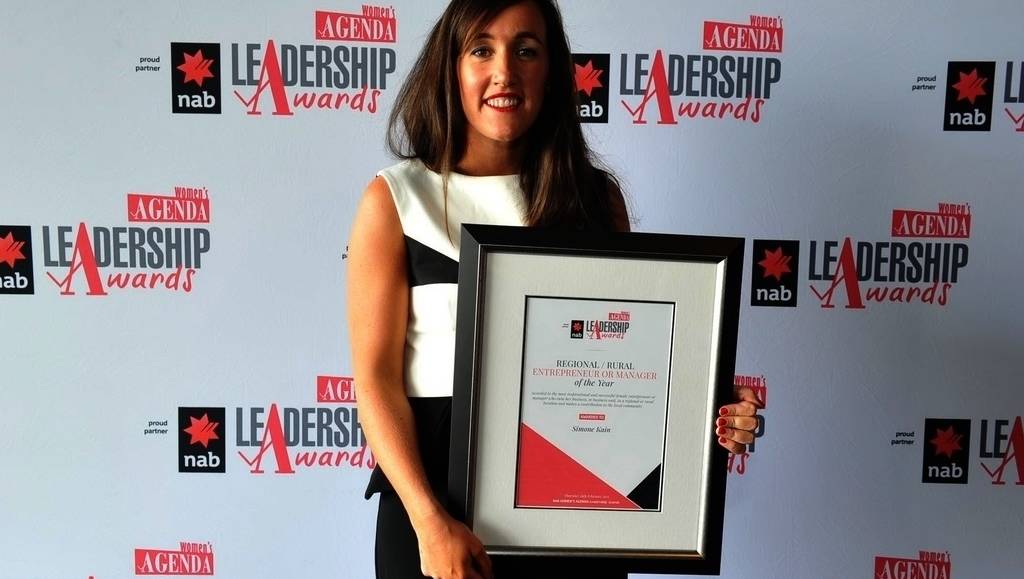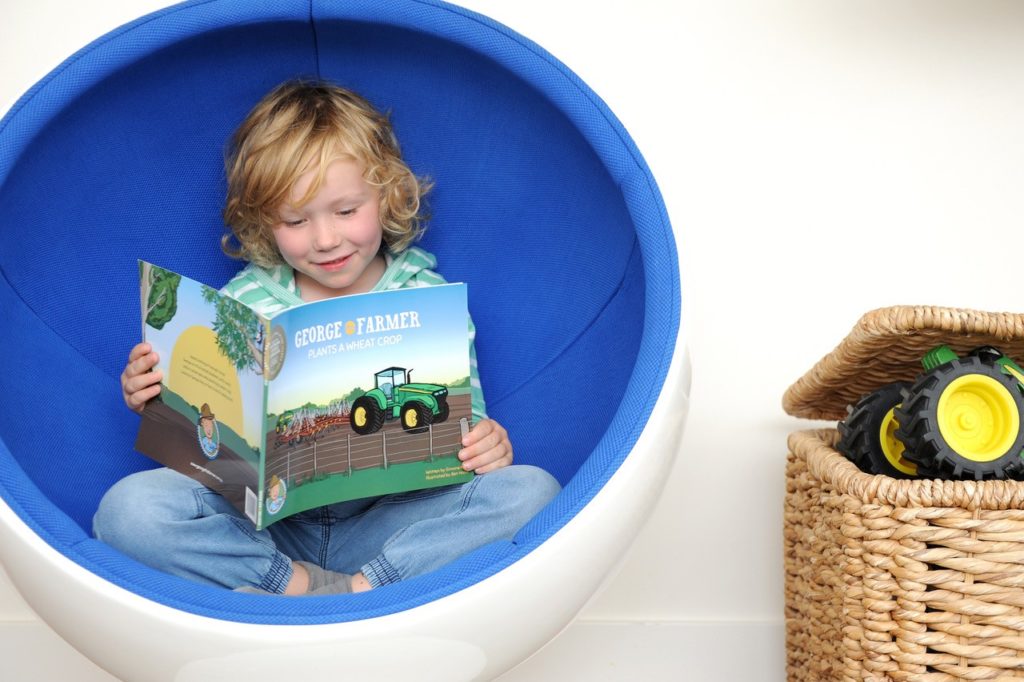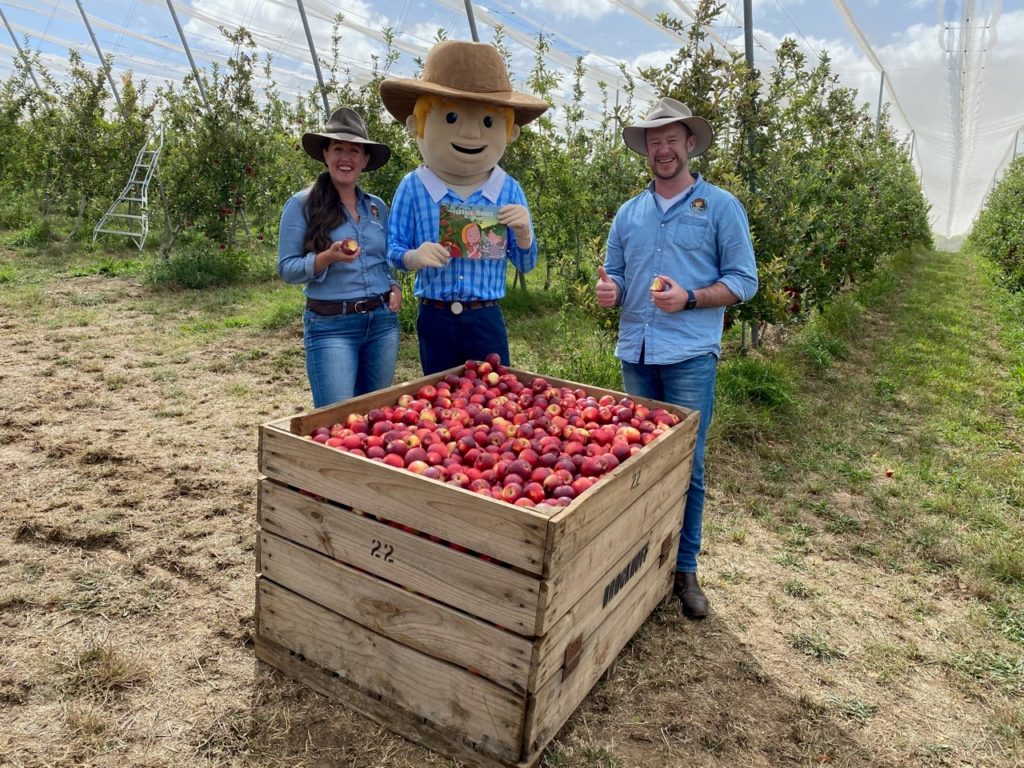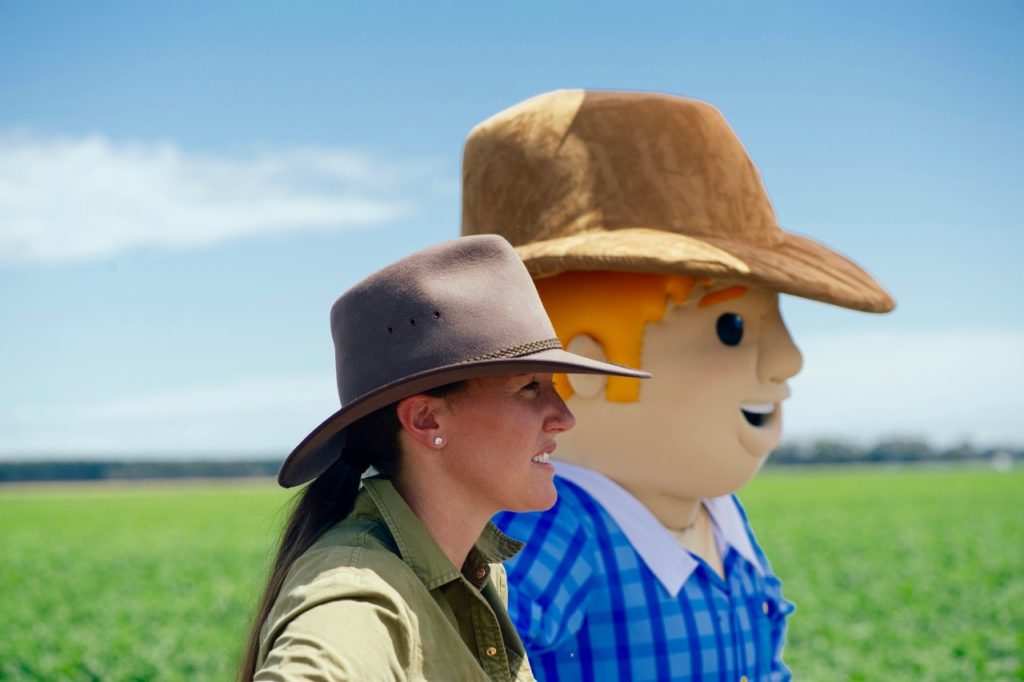We’re profiling women working in agriculture and related fields, thanks to the excellent support of AgriFutures Australia, in line with our weekly publication for women in agriculture, The Ag Wrap.
Simone Kain is changing how children think about where their food comes from, through a simple character called George.
Growing up on a mixed sheep and cropping farm, she became passionate about rural Australia at an early age, and returned to her roots after attending boarding school in Adelaide.
Now as a mother of 3, her strongest desire is to inspire her children and other kids alike, on how important agriculture is to their everyday lives.
She was particularly alarmed by some stats she read on where kids thought their food was coming from, including the finding that one third of Australian year 6 kids thought yoghurt came from a plant.
In 2014, Simone proposed the idea of an educational brand dedicated to teaching children about farming practices along with how food and fibre is produced. This was where the character of George The Farmer came to life — bringing together a character and business that saw Simone named Women’s Agenda’s 2015 Emerging Entrepreneur of the Year.
George has become a figure featured in books, TV and music, to connect kids to food and farm. They have since released ten picture story books. Their latest book, ‘George the Farmer Hailstorm Heroes’, just released last Friday.
And Simone has gone on to win more awards, including the 2017 SA AgriFutures Rural Women’s Award, and subsequently being named the National Runner Up.
Women’s Agenda spoke with the entrepreneur to listen to her thoughts on her purposeful career journey, and what the future holds for her business.

Tell us a little bit about your background and your passion for rural Australia?
I grew up on a sheep and cropping property in regional South Australia.
My parents also had a livestock transport business that they operated from our home base. I was always surrounded by busy people involved in agriculture — truck drivers, farmers, shearers and livestock agents from a young age.
It was like a big, extended farming family. I went away to boarding school in Adelaide and really enjoyed it, but was keen to return home. I returned after Year 12 and was awarded a multimedia traineeship at a government organisation after which I established my first business in website development at the age of 18 in 1998 after identifying the internet as having massive potential, coupled with the fact there wasn’t really anyone working in that space in regional SA at that time.
It was then that I realised how passionate and connected to rural Australia I actually was. I wanted to see the people, businesses and industries that are based in rural Australia really succeed.
You are the co-creator of George the Farmer, which aims to educate children about farming practices along with how food and fibre is produced. What sparked this idea and how were you able to bring the character to life?
In July 2012, I was lying on my bed one afternoon with my then 2 year old son, George, stretching out my rather large pregnant belly (I was pregnant with twins). I was trying to find some fun farming apps or books for George to keep him entertained when his new brothers arrived. He was obsessed with the farm and any opportunity that he had to go on our farm with Justin or to look at magazines with trucks, harvesters or tractors, he’d jump at it.
In my search, all that I could find were American or English stories that used different terminology – such as barn instead of shed – or field instead of paddock – and there also wasn’t one character who was telling sequential stories about life on the land.
At this same time, our local economy was slowing due to the ongoing effects of the Global Financial Crisis and Ben (my new business partner) and I had been actively thinking of new ways to bring in additional revenue to sustain our business – most of these ideas were focusing on app development.
So after an unsuccessful search to find a farming character, I suggested to Ben that we create our own character in-house utilising our creative, tech and marketing skills.
I’d always wanted to write a children’s book and Ben was getting in to illustrating at the time, so we decided to write and illustrate a story to potentially inspire lots of little farming kids, just like George, across the country – and if we created it as an interactive story app we could then use the app in our folio to try and gain future app clients for our creative agency.
Although the idea for George was to be inspirational, it wasn’t long into developing the brand and the first story that I came across some pretty staggering statistics which made us rethink what George’s main purpose should be.
A survey released in 2012 revealed that almost 1/3 of Australian Year 6 kids thought yoghurt came from a plant, 75% thought that cotton came from an animal and 45% didn’t associate basic lunch box items such as a piece of bread, a banana or some cheese as originating from a farm.
This blew me away. Coming from a farming background and being married to a farmer, I found it hard to believe that there was this massive disconnect occurring between those who play such an important role of producing our beautiful, clean green food that we’re lucky to enjoy here in Australia – and those who eat it. It was then that I realised not only did the character need to be inspirational, it needed to be educational. And although George the Farmer is named after my son, George, it was really important that there was good female representation in the stories. George is joined by his very smart and talented wife, Dr Ruby, who is an agronomist and has a PhD in viticulture.
From this humble idea, we have now published ten picture story books, a range of merchandise including Australian made out of Australian cotton t-shirts and cuddle dolls, paddock to plate live action videos which air on YouTube and ABC iView as well as a series of free curriculum-aligned educators guides to assist teachers to educate kids about agriculture in the classroom while also ticking off STEAM subjects (science, technology, engineering, arts, maths) for Foundation to Year 4. We are a social enterprise and reinvest a portion of our book sale profits into producing our free to use educational content.
What is the greatest lesson you want children to learn from George the Farmer?
Our vision is a world where children connect to the earth, food and farm — and that is the lesson that I want children to learn from George the Farmer. That we’re all connected to agriculture – And not one single person can sustain their life without food to nourish their bodies whether they eat an unrestricted diet or are vegan.
Many of us also use fibres like wool and cotton to clothe us, leather for our shoes and also fibres like timber for shelter. Those living in the city may be quite unfamiliar with the role agriculture and farming play in our lives, but we are all connected through food and fibre.
The more consumers know about where their food and fibre comes from, the better supported the agricultural sector will be.

You are known to be a very successful woman in the agricultural sector. How have you stayed innovative and creative in your business. How do you keep it moving forward?
I have always quite actively scanned for opportunities to network or learn. LinkedIn is great for that. One of the first really great opportunities that I came across on that platform was to participate in the Woolworths Ag Business Scholarship in 2015 which included a 2 week residential course onsite at Bella Vista in Sydney.
I learnt so much from that experience and the other thirteen attendees who were all involved in different areas of agriculture and from right across Australia and New Zealand. In fact, the third picture story book idea came from that trip when I met Robbie who was a robotic dairy technician from Western Australia. He logged in to his clients dairy’s from his phone and showed me what the cows were up to in real time — one was having a back scratch on an automatic back scratcher — and I thought, wow, the kids would love to learn about this!
Being involved with AgriFutures Australia has also been instrumental for my networking and for learning so much information across the entire agricultural sector. I’ve also been able to apply some of that knowledge to other roles locally — for example I also sit on the board for Regional Development Australia Limestone Coast where information that I learn through Agrifutures is very relevant to my local area and vice versa.
I read often. Audio books are my life! I drive to them, clean to them, run to them. There’s so much knowledge available. It’s when I’m listening to these books that an idea is often sparked for a new project or product.
What are the greatest challenges you faced in this space?
The greatest challenge that we face with George the Farmer is getting our picture story books, free paddock to plate videos and free teaching resources in front of children in metropolitan areas.
We have found that city kids are equally as enthused with George the Farmer as their regional counterparts when given the opportunity to learn from and have fun with him. However, farming is not necessarily a brand or concept that parents commonly gravitate towards. My message to those parents is to give him a try — kids love George’s funny stories — and even though they’re very simple — parents also learn something from them.

What are your hopes for the future, moving forward with your business?
I would love to see George the Farmer book packs in every childcare centre and school across the country. We’re currently seeking partners to make this happen. We have just released our tenth picture story book, ‘George the Farmer Hailstorm Heroes’ which focuses on the weather, apple harvest and food waste. Other titles cover topics of grains, shearing, bees, eggs, technology, dairy and vegetables. Agriculture is so diverse, and there are so many other topics that we will cover over the coming years.
This year we are working on the federally funded Kids to Farms project within South Australia and the Northern Territory which will see us deliver four new paddock to plate videos with accompanying Virtual Reality (VR) experiences and also curriculum-aligned educators guides for Foundation – Year 4 shot within South Australia and an additional three videos shot in the Northern Territory. All of this content will be available for teachers and the public to use for free from mid-August. We currently have two of our existing paddock to plate videos airing on ABC Education and ABC iView and hope that the next four will also be acquired this year.
My overall hope is that George the Farmer and subsequently agriculture become household names and topics in the not too distant future. When someone’s eating an apple in their house they say, ‘Did you know that a special camera takes 60 images of each apple every second in the packing shed to determine its eating quality before it’s sent to the supermarket? That’s why this is so delicious. I learnt that from the George the Farmer Hailstorm Heroes book!’
How did winning an Agrifutures Rural Women’s Award, and becoming a member of their Ignite Advisory Panel, help support your work and career?
Winning the 2017 SA AgriFutures Rural Women’s Award and subsequently becoming the National Runner Up provided me with this amazing platform to really share what it is that I’m doing with George the Farmer and Ruby.
You become part of a national network – not just with the people that you meet – but the people that they know as well – and you really can’t put a price on that. And likewise, the Ignite Advisory Panel has been very similar. I’ve learnt so much through the panel, and have been inspired with ideas for books and been able to take information about emerging industries and national rural issues to my region of the Limestone Coast in South Australia.
I was also invited to sit on the Department of Agriculture and Water’s Rural R&D for Profit Assessment Panel where we reviewed applications from research and development corporations to assess and distribute a share of a $40m pool of funding.
To learn more about George The Farmer, visit www.georgethefarmer.com.au


